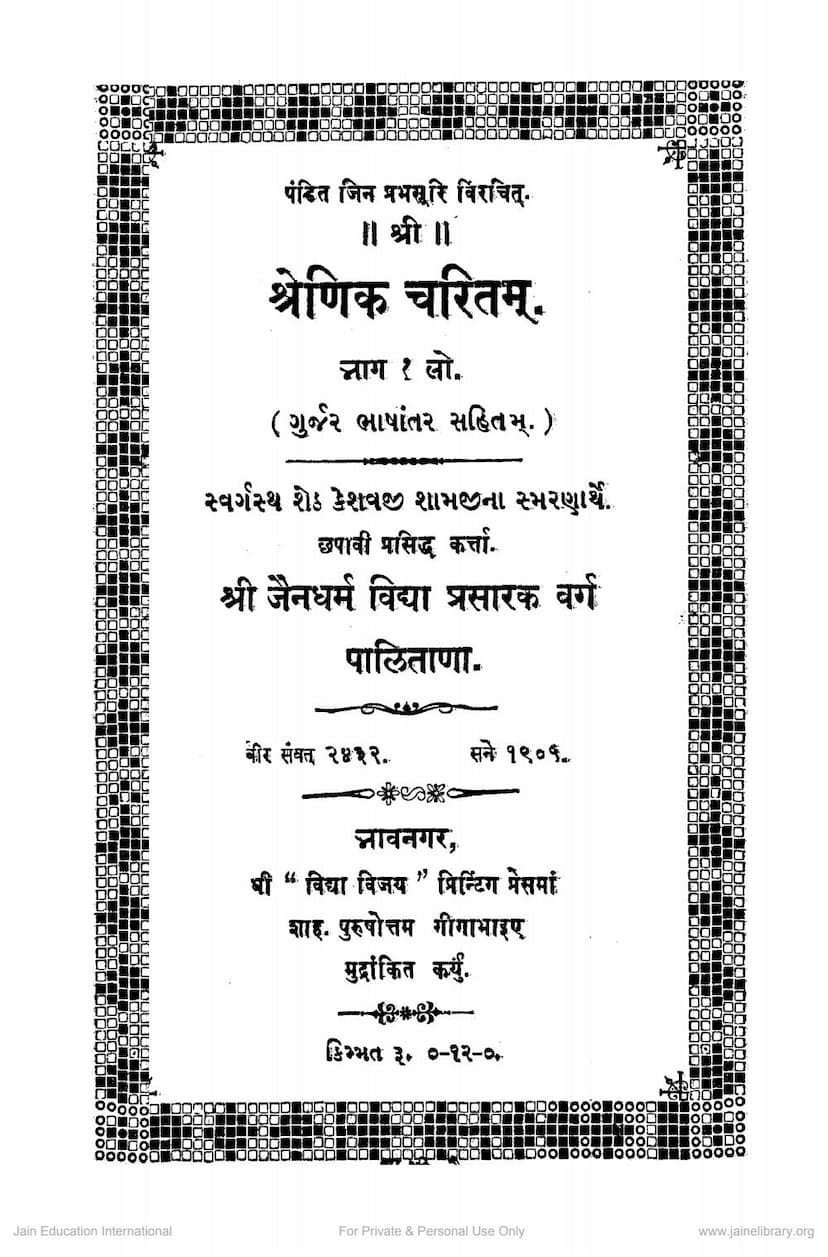Shrenik Charitam
Added to library: September 2, 2025

Summary
Here's a comprehensive summary of the Jain text "Shrenik Charitam" by Jinprabhsuri, based on the provided catalog link and the text itself:
Shrenik Charitam: A Summary
Title: Shrenik Charitam (श्रेणिक चरितम्) Author: Jinprabhsuri (पंडित जिन प्रसूरि) Publisher: Jain Dharm Vidya Prasarak Varg, Palitana (श्री जैनधर्म विद्या प्रसारक वर्ग, पालिताणा) Publication Year: V.S. 2432 / 1909 CE
Overview:
"Shrenik Charitam" is a significant Mahakavya (epic poem) authored by the esteemed Jain Acharya Jinprabhsuri. The work is unique in its integration of Sanskrit grammar principles with a narrative of righteousness and devotion. It is dedicated to the memory of the late Seth Keshavji Shamji. The catalog link and the provided text indicate that this is a comprehensive work, likely structured into several sargas (cantos). The primary focus of the summary will be on the content of the initial sargas provided.
Core Purpose and Structure:
The text is presented as an educational and inspiring work aimed at deepening the reader's understanding of Sanskrit grammar through the engaging medium of a biographical narrative. The author's intent, as stated in the preface (Prastavana), is to help students of Sanskrit grammar reinforce their knowledge by illustrating grammatical rules and forms through the story of a prominent religious figure. The composition adheres strictly to poetic conventions, maintaining a consistent flow of expression and artistic rules.
Integration of Grammar and Narrative:
The unique strength of "Shrenik Charitam" lies in its successful blend of a captivating narrative with detailed grammatical exposition. Each sarga is designed to showcase specific chapters of Sanskrit grammar, such as Sandhi (euphonic combination), Naming conventions (Namānuvṛtti), Karaka Vibhakti (case relations), Taddhita (suffixation), and Dhātu (root conjugations). These grammatical concepts are seamlessly woven into the life story of King Shrenik of Magadha.
Key Themes and Content (Based on the provided Sargas):
The provided text covers the initial sargas of the Mahakavya, offering insights into:
-
Chapter 1 (Desh Magadh Nayak Varnan - Description of Magadha and its King):
- Description of Magadha: The first sarga introduces the land of Magadha, its capital, and the esteemed King Shrenik.
- Sandhi Exposition: It illustrates the concept of Sandhi, showcasing different forms of the Pancha Sandhi (five types of euphonic combination) within Sanskrit grammar.
- Naming Conventions: The sarga also delves into naming conventions, demonstrating various siddha rūpa (grammatically correct forms) of nouns, exemplified through the descriptions of King Shrenik's queen, Devi, and his son.
- Vyanjana Sandhi: The text demonstrates Vyanjana Sandhi (consonant sandhi) with examples like Sumraapira.
- Kāraka Vibhakti: It further illustrates Kāraka Vibhakti (case relations) through examples depicting King Shrenik's journey.
- Taddhita Pratyaya: The text explains Taddhita Pratyaya (nominal suffixes) with examples from the description of the Tirtha (sacred site).
- Dhātu Prakriyā: It demonstrates the initial stages of Dhātu Prakriyā (verb root conjugation) in the description of Lord Mahavir's teachings.
- Darshak Dev: The seventh sarga describes the vision of a celestial being and the marvel of its speech, continuing the Dhātu Prakriyā.
- Poetic Excellence: The overall assessment of the first part highlights its exceptional composition, melodious wordplay, engaging narrative, elevated sentiments, and the natural, graceful integration of grammatical aspects, all imbued with a Jain sensibility.
-
Chapters 2 & 3 (Couplets and Descriptions): These sections continue to present verses that illustrate various grammatical rules and poetic devices, often using descriptions of nature, characters, and societal aspects to serve as examples. The focus remains on demonstrating Sanskrit grammar within a narrative framework.
-
Author and His Works: The preface also provides a brief biography of the author, Jinprabhsuri, who was a disciple of Jinahamsuri and the founder of the Laghu Kharatar Gacch. He is noted for his prolific writing, including commentaries and numerous stotra (hymns) composed with a deep devotion. His rule of composing at least one new stotra daily before eating is mentioned.
Key Figures:
- King Shrenik: The central character of the epic, a righteous and devoted ruler of Magadha.
- Lord Mahavir: The Tirthankar whose teachings and presence are central to the narrative.
- Jinprabhsuri: The renowned author and scholar.
Literary and Grammatical Significance:
"Shrenik Charitam" is lauded for its:
- Literary Merit: It is considered a "Mahakavya" due to its adherence to poetic structure, noble themes, and probable grand scale.
- Grammatical Pedagogy: The meticulous integration of Sanskrit grammar rules makes it an invaluable resource for learning and reinforcing grammatical knowledge.
- Devotional Content: The narrative is steeped in Jain philosophy and devotion to the Tirthankaras, particularly Lord Mahavir.
- Inspirational Narrative: The life of King Shrenik serves as a model of righteousness, virtue, and devotion.
Translation and Challenges:
The preface acknowledges that the translation primarily relies on the literal meaning of the text. The intention was to provide a commentary for deeper understanding, especially for grammatical points, but such a commentary was unavailable. The translation process faced challenges due to the scarcity of accurate manuscripts, with the current translation being based on a single, somewhat error-prone, manuscript. The translators express humility and request forgiveness for any remaining inaccuracies.
Dedication and Social Context:
The publication is a memorial to the late Seth Keshavji Shamji, sponsored by his sons. This highlights a tradition of charitable and commemorative publishing within the Jain community, where religious texts are brought forth to honor esteemed individuals and contribute to religious education.
In essence, "Shrenik Charitam" is a scholarly and devotional masterpiece that bridges the gap between linguistic study and spiritual narrative, offering a rich tapestry of Jain teachings and grammatical insights.